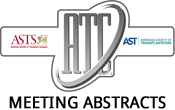2018 American Transplant Congress
hEPCR.hTBM.hCD47.HO-1 Contributes to Increased Survival, Reduced Platelet Sequestration, and Modulation of Coagulation Activation in GalTKO.hCD46 Porcine Livers Perfused with Human Blood
1University of Maryland School of Medicine, Baltimore, MD; 2Revivicor, Inc., Baltimore, MD.
IntroductionPlatelet sequestration and inappropriate coagulation cascade activation are associated with poor outcomes in multiple liver xenotransplant models. Here we evaluate a cassette of additional genetic…2018 American Transplant Congress
Effects of Sarcopenia on Patients Undergoing Liver Re-Transplantation
Transplant Surgery, Henry Ford Health System, Detroit, MI.
Background:Loss of muscle mass (sarcopenia) has been found to be a measure of mortality after primary liver transplantation. We aimed to evaluate its effect in…2018 American Transplant Congress
Human Endothelial-Like Cells Transdifferentiated from Peripheral CD14+ Monocytes Inhibit T Cells in Response to Allo-Stimulation
Gastroenterological and Transplant Surgery, Hiroshima University, Hiroshima, Japan.
We have previously demonstrated that the endothelial cells located in immune-privilege sites, such as livers, suppress T-cells in response to both of direct and indirect…2018 American Transplant Congress
Oral Vancomycin Monotherapy versus Combination Therapy in Solid Organ Transplant Recipients with Uncomplicated Clostridium difficile Infection: A Retrospective Cohort Study
Introduction:Solid organ transplant (SOT) recipients are at high risk of Clostridium difficile infection (CDI) and CDI recurrence. A combination of metronidazole and oral vancomycin is…2017 American Transplant Congress
MELD Exception Score: LSAM Modeling of a Fixed Floor.
Current US liver allocation policy grants standard MELD score exceptions beginning at 22 points and rising every 3 months. Scores for hepatocellular cancer are delayed…2017 American Transplant Congress
Porcine Albumin Elaboration During Perfusion of Transgenic Porcine Livers with Human Blood.
PurposeIn addition to immune barriers, molecular incompatibilities between species are predicted to limit pig liver survival in primate xenotransplantation models. How perfusion with human blood…2017 American Transplant Congress
NAFLD in Kidney Transplant Candidates.
Tampa General Medical Group, Tampa, FL
Non-alcoholic fatty liver disease (NAFLD) is becoming the leading cause for liver transplant, and it is the most rapidly growing indication for simultaneous liver-kidney transplant…2017 American Transplant Congress
Women Are Delisted for Being Too Sick for Liver Transplant More Frequently Than Men.
University of California - San Francisco, San Francisco, CA
Background: Women (W) with cirrhosis awaiting liver transplantation (LT) experience higher rates of waitlist mortality than men (M). We aimed to understand the impact of…2017 American Transplant Congress
The Adoption of Generic Immunosuppressant Medications Among Kidney and Liver Transplant Recipients Using the Colorado All Payer Claims Database.
Background: Substitution of generic for brand-name immunosuppressants has increased in solid organ transplantation following the expiration of brand patents. Our aim was to describe the…2017 American Transplant Congress
Polycystic Liver Disease Patients May Not Be Appropriately Represented by MELD Exception Policy.
Purpose: Polycystic liver disease (PCLD) is a rare, but important disease whose mortality is not fully predicted by MELD score. Most patients with PCLD maintain…
- « Previous Page
- 1
- …
- 35
- 36
- 37
- 38
- 39
- …
- 50
- Next Page »
